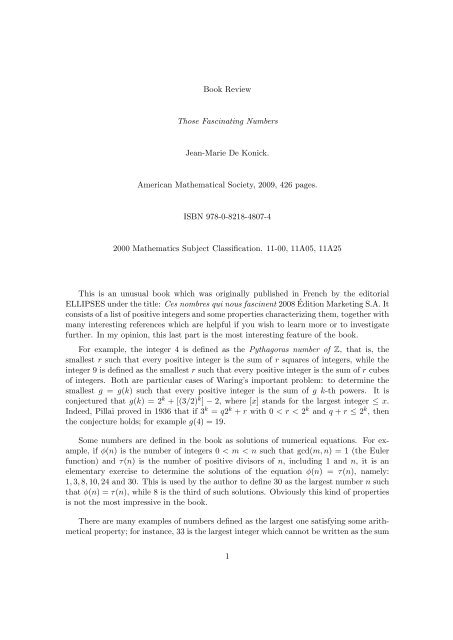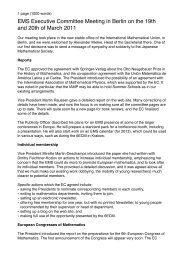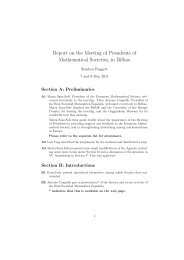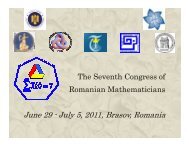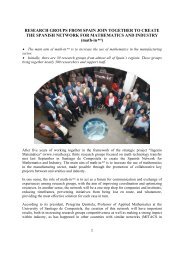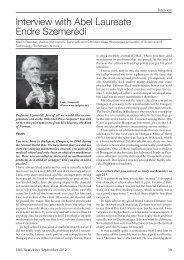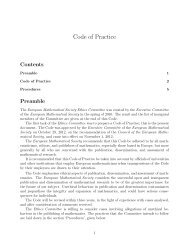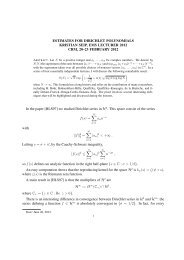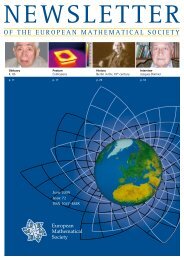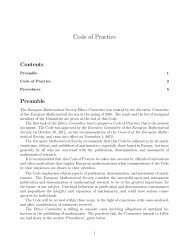Book Review Those Fascinating Numbers Jean-Marie De Konick ...
Book Review Those Fascinating Numbers Jean-Marie De Konick ...
Book Review Those Fascinating Numbers Jean-Marie De Konick ...
You also want an ePaper? Increase the reach of your titles
YUMPU automatically turns print PDFs into web optimized ePapers that Google loves.
<strong>Book</strong> <strong>Review</strong><br />
<strong>Those</strong> <strong>Fascinating</strong> <strong>Numbers</strong><br />
<strong>Jean</strong>-<strong>Marie</strong> <strong>De</strong> <strong>Konick</strong>.<br />
American Mathematical Society, 2009, 426 pages.<br />
ISBN 978-0-8218-4807-4<br />
2000 Mathematics Subject Classification. 11-00, 11A05, 11A25<br />
This is an unusual book which was originally published in French by the editorial<br />
ELLIPSES under the title: Ces nombres qui nous fascinent 2008 Édition Marketing S.A. It<br />
consists of a list of positive integers and some properties characterizing them, together with<br />
many interesting references which are helpful if you wish to learn more or to investigate<br />
further. In my opinion, this last part is the most interesting feature of the book.<br />
For example, the integer 4 is defined as the Pythagoras number of Z, that is, the<br />
smallest r such that every positive integer is the sum of r squares of integers, while the<br />
integer 9 is defined as the smallest r such that every positive integer is the sum of r cubes<br />
of integers. Both are particular cases of Waring’s important problem: to determine the<br />
smallest g = g(k) such that every positive integer is the sum of g k-th powers. It is<br />
conjectured that g(k) = 2 k + [(3/2) k ] − 2, where [x] stands for the largest integer ≤ x.<br />
Indeed, Pillai proved in 1936 that if 3 k = q2 k + r with 0 < r < 2 k and q + r ≤ 2 k , then<br />
the conjecture holds; for example g(4) = 19.<br />
Some numbers are defined in the book as solutions of numerical equations. For example,<br />
if φ(n) is the number of integers 0 < m < n such that gcd(m, n) = 1 (the Euler<br />
function) and τ(n) is the number of positive divisors of n, including 1 and n, it is an<br />
elementary exercise to determine the solutions of the equation φ(n) = τ(n), namely:<br />
1, 3, 8, 10, 24 and 30. This is used by the author to define 30 as the largest number n such<br />
that φ(n) = τ(n), while 8 is the third of such solutions. Obviously this kind of properties<br />
is not the most impressive in the book.<br />
There are many examples of numbers defined as the largest one satisfying some arithmetical<br />
property; for instance, 33 is the largest integer which cannot be written as the sum<br />
1
of five non zero squares, the other ones being 1, 2, 3, 4, 6, 7, 9, 10, 12, 15 and 18. It has been<br />
more surprising for me to find out that 77 is the largest integer which cannot be written<br />
as the sum of positive integers whose sum of reciprocals equals 1. For example,<br />
78 = 2 + 6 + 8 + 10 + 12 + 40, and 1 1 1 1 1 1<br />
+ + + + + = 1.<br />
2 6 8 10 12 40<br />
Indeed what is deeper is that, in both cases, almost all positive integers satisfy the studied<br />
property.<br />
The last number studied in the book is s = 10101034 , known as the Skewes number. To<br />
explain its interest some notation is needed. Let π(x) be the number of prime numbers<br />
≤ x, and consider the so called logarithmic integral<br />
Li(x) =<br />
x<br />
0<br />
dt<br />
log t .<br />
Many great mathematicians, Gauss and Riemann being two of them, believed that π(x) <<br />
Li(x) for all x ≥ 2, an inequality which can be verified for all x < 10 23 , but which is not<br />
always true. Indeed, Littlewood proved in 1923 that the difference π(x) − Li(x) changes<br />
its sign infinitely often. Skewes proved in 1933, assuming the Riemann hipothesis, that<br />
the smallest number x0 for which π(x0) > Li(x0) satisfies x0 < s, a result which was<br />
considered very significant at that moment. In fact, as far as I know, the exact value of<br />
x0 is unknown.<br />
As expected, other examples in the book are not so exciting. For example, the integer<br />
11 is the smallest prime number p such that 3 p−1 ≡ 1 mod p 2 , and 43 is the fourth prime p<br />
such that 19 p−1 ≡ 1 mod p 2 but the author does not give extra information to understand<br />
why congruences of the form r p−1 ≡ 1 mod p 2 are interesting.<br />
In my opinion, this is a book for browsing rather than for sustained reading, but all in<br />
all it introduces interesting notions and problems in number theory.<br />
2


